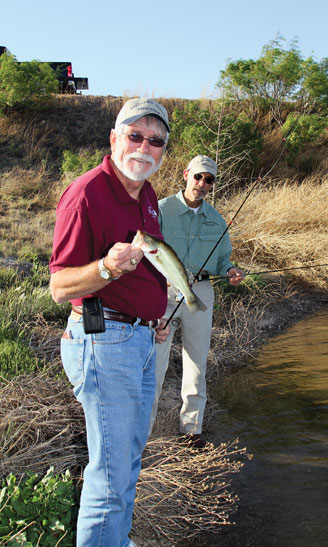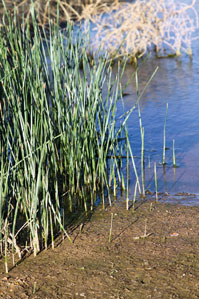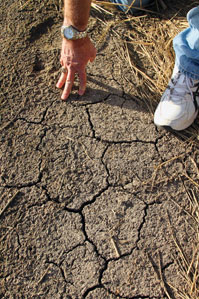
Karl Wolfshohl
Dr. Jim Rogers, left, displays the benefits of a well-constructed pond with Panhandle-Plains Land Bank Senior Vice President Kenneth Hooper.
Four years ago Dr. Jim Rogers and his wife, Pamela, purchased 700 acres of ranchland south of Clarendon, Texas, for recreation and family gatherings. With abundant wild game, brush-covered hills and two miles of Mulberry Creek running through it, the Panhandle ranch provided the perfect setting for their weekend home.
The property lacked one feature they wanted, however — a pond to attract wildlife.
“Watching turkeys is why my wife comes out here,” says Rogers, who is a professor of environmental science and associate dean at West Texas A&M University in Canyon, Texas. “Most of the game is down by the creek, and we didn't build our house there because of potential flooding.”
Improving the Habitat and the View
To remedy the situation, the couple is planning to build a small wildlife-viewing pond this year, with help from their son, Nick, whose business, Rocking R Fencing Co., constructs ponds and game fences.
“We'll bring deer and turkeys close to the house by improving the habitat and building this small pond,” says Rogers. Eventually, they want to also build a much larger pond farther from the house that will be designed differently to attract waterfowl for hunting.
Regardless of the size or the purpose of the ponds, you can be sure they will be built correctly — to Rogers' high standards.
As an environmental scientist and consultant, Rogers has extensive experience building water structures and waste-management systems. He has advised landowners on how to build new ponds and correct problems with existing ones. He also has consulted on hazardous waste–handling systems throughout the United States and in foreign countries — systems that often use many of the same materials and principles that are used in pond construction.
Different Vegetation for Different Creatures
Rogers says the type of wildlife you want to attract should determine how you build your pond.

Karl Wolfshohl
Tall grasses provide cover for ducks and geese.
“If you want wetland habitat, then 50 percent vegetative cover and 50 percent open water is a nice combination for waterfowl, and this also works nicely for largemouth bass.”
– Dr. Jim Rogers
“Doves are drawn to ponds that do not have tall vegetation around their edges,” he says. “They like ponds that livestock would use, and keep the shores trampled down, because they like a place to light. They also like a pond that's surrounded by sand and gravel, so they can pick up their gravel and water at the same time.”
He says turkeys do not like heavy vegetation around the water's edge, either, because of predators. “You may want to mow vegetation around the edges for doves and turkeys,” he says.
Ducks and geese are a different story. They prefer plenty of cover, both around and on the water.
“Cattails, sedges and other wetland vegetation are important for waterfowl, because they use it as a refuge during foul weather,” he says. “If you want wetland habitat, then 50 percent vegetative cover and 50 percent open water is a nice combination for waterfowl, and this also works nicely for largemouth bass.”
Rogers plans to make his new pond attractive to deer by locating it near a food plot in which winter wheat provides needed winter forage. Fed from a shallow aquifer using a solar-powered pump, the pond will be maintained with a gently sloping, sandy beach on the bank for deer, turkeys, doves and human swimmers.
“On the far side, I'll have an area with cattails and sedges growing, which attract waterfowl and are pleasing to see,” he says. “I control cattails with water depth. Typically when your water is over 5 feet deep, there are no cattails.”
Rogers plans to use a synthetic material called HDPE (high-density polyethylene) to line the small pond, which will be about one-third of an acre in size, and he will cover the liner with at least 1 foot of soil for aesthetics and so that aquatic plants can take root. In this case, he’ll use the liner to prevent leached water from drowning the roots of a nearby elm tree.
“Deer like to get in the water, which is why I use the 30-mil HDPE liner,” he says. “Their hooves can't puncture that material. And I'll construct the sides no steeper than a 3-to-1 slope (3 feet of horizontal run per 1 foot of drop), so they can get out.”
A Recipe That Holds Water
Rogers suggests a quick way to determine if soil is likely to hold water.
Take a fistful of soil. Moisten it to just short of the point where it becomes sticky. Roll it between your hands into a ribbon about one-eighth of an inch thick. If the soil ribbon holds together, Rogers says it may contain enough clay to hold water in a pond, providing there's a thick enough layer of it. If the ribbon breaks apart in your hands, the soil will need to be covered with something that will hold water.
When it comes to choosing a pond liner, there are essentially two types — natural clay and synthetic — and the choice may be driven by cost.
Rogers tells the story of a rancher who developed land for home sites near Amarillo, Texas. One of his ponds was losing up to 3.3 inches of water per day.
“The average evaporation rate here is 0.2 to 0.3 inches per day, so that pond was losing three inches per day to seepage,” Rogers says. “It needed a liner.” The landowner chose a natural clay liner over a synthetic liner, because he could use the plentiful Randall clay on his ranch, and save on transportation costs.
Raising the Property Value
Adding a water structure to a dry West Texas property may significantly increase its value, notes Kenneth Hooper.
Hooper is senior vice president of Panhandle-Plains Land Bank in Plainview, Texas, which financed the country home for Rogers and his wife, and has financed pond construction for other customers in the region. This lender says a spring, a wet-weather creek or a pond may all have this effect. “We call it a water adjustment,” he says.
Hooper points out that a small well, pumped by a windmill as a water source for cattle, doesn't normally add to the value of property in the Panhandle area. “But taking in an existing feature such as a dry stream bed and dredging a pond it does,” he says.
State-certified general appraiser Talmadge Porter of Childress, Texas, concurs. “At its peak a couple of years ago, a section of land with live water, such as an all-weather creek, would sell for $1,200 to $1,300 per acre — at least 25 percent to 30 percent higher than land without live water. This kind of land is still bringing $1,000 to $1,100 per acre,” he says. Porter, who is a retired Farm Credit association president, reports that ponds that hold water year-round “fall right in there with live water” in enhancing land's value.
“Folks often think about the Land Bank as a source of financing for purchase of land, but it's more than that,” Hooper says. “Long-term financing can be put to good use for improvements that increase the value of the land, as well, whether it's agricultural or recreational. And we offer a competitive, fixed rate with patronage profit-sharing programs.”
– Karl Wolfshohl

- Karl Wolfshohl
Cracks are an indicator of clay soil, which is a good natural liner for ponds.
Tips on Designing and Lining a Pond
As both an internationally recognized expert on waste management and a consultant on pond construction, Dr. Jim Rogers has had plenty of experience building and lining ponds. He offers the following general advice on pond building, but points out that each situation calls for its own plan.
As a pond liner, high-density polyethylene is resistant to ultraviolet light.
- If you need a liner, use clay when it's available nearby, because the transportation will be relatively inexpensive.
- Clay should be placed and compacted into a layer at least 12 inches thick for a pond up to 10 feet deep. Increase this thickness by 1 inch for each foot of water over 10 feet.
- Don't be concerned if you see surface cracks along a dry pond edge; they will come together again when wet. Cracks are a sign of a clay bottom.
- Rogers has used four kinds of synthetic liners, each with pros and cons. The two he has used most often are HDPE and PVC. His favorite, HDPE, is resistant to ultraviolet light and more durable against animal hooves than PVC, which must be covered where exposed to sunlight. HDPE's disadvantage is that it must be welded using specialized equipment. Both types should be put down wrinkly, not smooth, because adding cold water will draw them tight, compromising the anchoring system.
- Synthetic liners should be placed in a cutoff trench around the pond's edge, with soil covering the liner and filling the trench. Rogers recommends that these trenches be two feet deep.
- Be careful how deeply you dig. Some ponds that hold water efficiently begin to leak when you dig through their clay bottoms, trying to make them deeper.
- Be careful of slope. “I never recommend a slope with less than 2 feet of horizontal run for each foot of vertical drop,” Rogers says. “A lined pond with steep sides is a hazard to children and wildlife.”
- Be mindful of depth. “In cold areas like the Panhandle, make sure there’s water at least 5 to 6 feet deep for thermal protection for fish, and shallow areas productive (with rooted vegetation) for wildlife,” Rogers says.